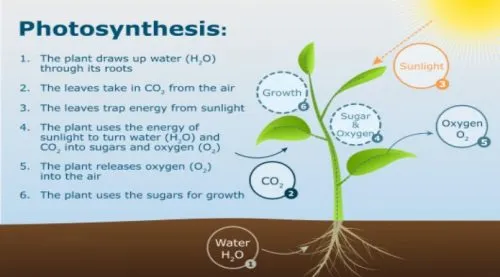Photosynthesis takes a portion of the energy the plant requires in light, converts it to chemical energy, and stores it in carbon bonds. You are probably familiar with the general principle represented in the following chemical equation:
6CO2 + 6H2O + Light + C6H12O6 + 6O2

Which shows that carbon dioxide (CO2) plus water (H2O) in the presence of light yields glucose (C6H12O6) and oxygen (O2). Glucose, of course , is a sugar and it has five carbon bonds that store energy. The glucose equation represents the major purpose and events in photosynthesis, but it is an oversimplification. In fact, much of the energy from light is converted into glucose, which is temporarily stored as starch in the chloroplast where it is produced. However Glucose is not the only sugar produced by photosynthesis. Other sugars are produced that are used to synthesize amino acids and fatty acids for the consumption of proteins, lipids and other compounds necessary for plant survival.
There are two types of photosynthesis, warm season and cool season photosynthesis. Warm season photosynthesis is called C4 photosynthesis while cool season photosynthesis is called C3 photosynthesis. The terms C3 and C4 refer to the different pathways that plants use to capture carbon dioxide during photosynthesis. All species have the more primitive C3 pathway, but the additional C4 pathway evolved in species in the wet and dry tropics. The first product of carbon fixation in C3 plants involves a 3-carbon molecule, whilst C4 plants initially produce a 4-carbon molecule that then enters the C3 cycle.
Photosynthesis requires light, water and carbon dioxide. If one of these important components is low or missing photosynthesis will slow or stop completely. If the conditions do not improve the plant will become sick and eventually die. Other nutrients are required to perform photosynthesis as well but they are rarely in low supply and are not nearly as important as water, light and carbon dioxide.
The most important part of photosynthesis occurs in the chloroplasts. These small photosynthesis factories buried within the leaves house chlorophyll, a green pigment secreted in the chloroplast membranes. Chlorophyll absorbs a wide range of the spectrum of sunlight, giving the plant as much energy as it can for its reactions. The primary section of the light spectrum that chlorophyll doesn’t absorb is green, which explains why leaves usually appear as a shade of green. These green chloroplasts reside on the leaf’s interior. The epidermis, or the surface of the leaf, protects the processes occurring beneath.
